PAGE 82a – February 2009
H O T I D E A S F O R S M A L L R A I L R O A D S

The classic small-or-micro layout is a straight board around one foot (30cm) deep and 4 to 6 feet (120 to 180 cm) long. Here’s a collection of interesting examples in HO or smaller scales. This is Part 1… watch for Part 2 soon!
In This Issue
Guy’s Fizz-Bang Tram—Night-time fireworks for youngsters
Turtle Creek Industrial RR—N layout built in China
Marienbad—Period railroad & texture casting with wood glue
LLanast—N-scale version of classic Piano LIne
Mainlände—Medieval town and branch line terminal
Gotha—An Ethiopian railway station in 1923
Fuel Pad—A small showcase for models
LA Rat Hole District—Switching layout in downtown LA
Ulthwaite—Narrow gauge in the romantic English Lake District
Trackmobile Industry—Industrial switcher with Loco Lift cassettes
Ninove—Accurately modeled Belgian tram terminal
FUN FOR SMALL FRY AT THE FIREWORKS FACTORY
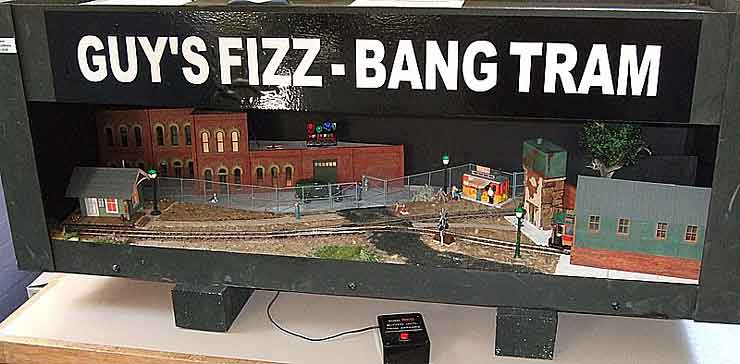
Wanting to provide a display other than Thomas the Tank Engine for youngsters at a train show, Gerry Bullock, from Essex, England, concocted this 48x16in (120x40cm) On30 layout, Guy’s Fizz-Bang Tram. It presents a night-time scene in a “black box” with a proscenium (picture frame) front, placed on a low tabletop so short people can see it easily. Gerry describes it thusly:
“This layout, built in ¼in scale on Peco O-16.5 Track, is aimed at the Younger Generation. All that is required to operate it is a push on the RED Button. It depicts the American Noise-R-Us Fireworks factory situated at a town called Fawkesville in the American Midwest.
“In view of the inherent danger when manufacturing fireworks the City Fathers of Fawkesville insisted on the factory being built some miles from the town in a semi-desert area. However they did agree to Noise-R-Us building a tramway (trolley line) from Fawkesville out to the factory. This enabled the workforce to easily reach their place of work. You will see the tram leave its shed and proceed to the factory station and then head out to Fawkesville before returning with some workers ready for the next shift.
“A chip controls both the sequence and the turnout motor; the surprise for kids is that part way through the sequence the Bachmann autoreversing tram goes back into shed and immediately comes out again.
“As it is dusk the buildings are lit, and there are some lamps to light the workers’ path to the factory and the Burger Bar. (You’ll note that the Burger Bar is well used—the owner offers free tea or Coke to anyone buying a Big-Burger!) You can’t miss the factory building, not only is it large it also has its own fireworks-display neon sign on the roof! You’ll also see that it’s a starlit night (and the stars twinkle…well, flash).”
The layout has proved immensely popular and not just with its intended audience! In the works currently is an LED starburst fireworks display that will climb the black backdrop and shower the scene with sparks.
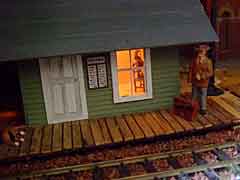
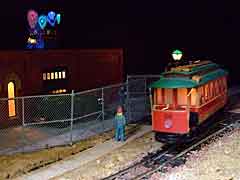
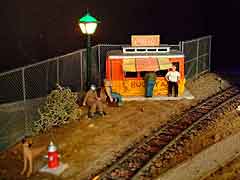
The above photos were all taken with extra lighting in order to show the layout’s construction and features. Gerry also made a short video of the scene operating in the dark, as it does at shows. For more photos of Guy’s Fizz-Bang Tram, see Gerry’swebsite. To see the video, just click on the triangle below.
U.S. SHORTLINE FROM DANISH WEBSITE WITH U.K. DESIGN WAS BUILT IN CHINA!
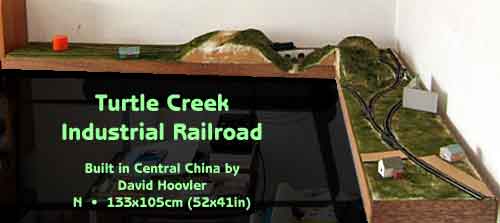
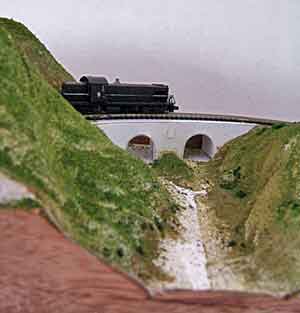
David Hoovler, from Butler, Pennsylvania USA, introduced this amazingly international small layout as follows: “I thought you might be interested in hearing how a Briton’s plan inspired by a Canadian portage layout wound up actually being built by an American living in China, based on a Pennsylvania prototype described on a Danish website!” The story began when David and his wife moved to Central China to teach English for three years…
He shipped himself a carton of N scale model railroad supplies, and began thinking about a layout in China. He had internet access there, and while studying this site became intrigued by Giles Barnabe’s Micro Portage Layout in Scrapbook#44. He built an L-shaped version of the layout, measuring 133x105cm (52x41in). At that point he happened upon Carl Lundsten’s railfanningwebsite, which describes the Turtle Creek Industrial Railroad, an 11-mile shortline in Pittsburgh not far from David’s hometown (and not far from this site’s editor’s home). And he noticed that, with only a few changes, his layout could be operated very much like this little line!
The result was the Turtle Creek Industrial RR, shown in the photos as constructed in China. David describes it, “The plan had the interchange with Conrail (now NS) in Trafford at the far left, with a spur for a fictional team track and oil dealer. Moving right (north), the line passed under the Pennsylvania Turnpike, then over Turtle Creek on a scratchbuilt (plastic) concrete bridge complete with a PRR keystone. Then the line turned east, entered Murrysville with service to a lumber dealer, passed the line to the old Export coal mine, and continued to Export and the Durabond steel plant there.
“Unfortunately, the demands of teaching and living in another culture slowed progress on the layout, and construction stalled at the point shown in the photos, before any buildings were built and with Turtle Creek still dry. But [now that I’m back in the U.S.] I may resurrect the idea in the future—it’s a compact plan with room for realistic scenery and operation.”
MARIENBAD OFFERS OLD-TIME FLAVOR AND A NEW BUILDING TECHNIQUE
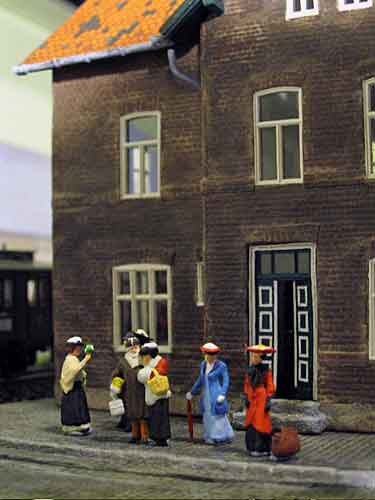
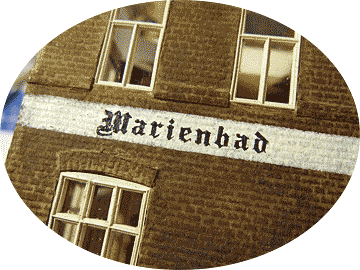
Marienbad is a modular, wall-mounted HO layout under construction by Sven van der Hart, from Utrecht in The Netherlands. Each module measures 60x35cm (24x15in), so the total layout is 3m (almost 10ft) long. This is Sven’s first attempt at scratchbuilding scenery and structures, and he’s finding it very enjoyable: “I’ve been building now for a year, and I notice that I’m still very motivated to work on it.” There’s more layout information on his website.
In the process, he’s discovered an interesting technique for using wood glue (carpenter’s glue) in aluminum foil molds to cast surface textures (several examples are illustrated in these photos, including the bricks on the station and the cobbles on the street). Sven calls it “glueprinting.” Others might call it “surface casting with wood glue.” Sven has a page of instructions online. [I’d be interested to hear about the experiences of anyone who tries the technique. —Carl.]

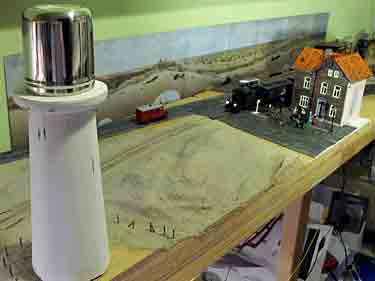
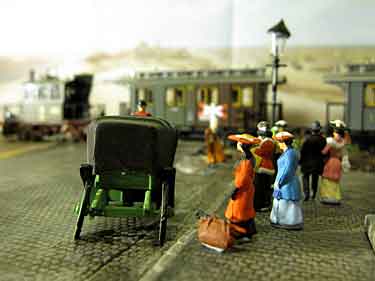
PIANO LINE PLAYS AGAIN… IN N SCALE THIS TIME

Having a “bit of spare wood” on hand measuring 36x6in (90x15cm), Alan Cox, from Swansea, Wales, decided to create an N-scale layout. He selected a classic track plan from the historical archives—The Piano Line, originally built in 1965 by the Rev. P.H. Heath. This plan was aamong the first to demonstrate the idea of bringing the main line onstage in the middle of the runaround loop (passing siding)… thus allowing very flexible operations in a very small space! (See Scrapbook #61a for more information.)
Alan’s version, called Llanast (Welsh for “a mess”), follows the Heath plan closely. Alan built it using Peco Set Track sections straight from the scrap box. The layout is currently at the “shining up” stage of adding bits and pieces, improving on areas that he can now do better, and the like. The plan itself allows considerable movement of both passengers and freight.
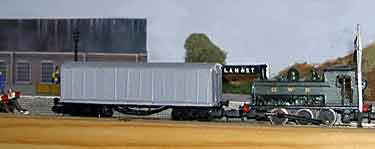
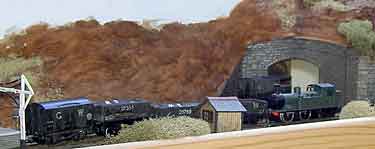
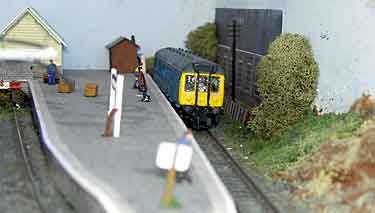
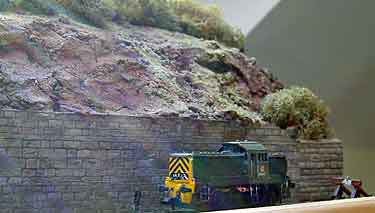
PICTURESQUE MEDIEVAL RIVER PORT WILL FEATURE DB CONNECTION

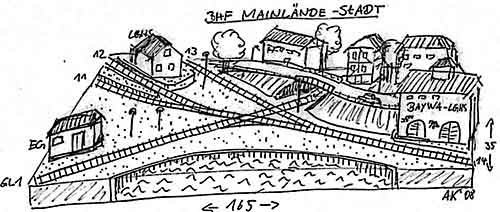
Mainlände Stadtbahnhof is an HO layout project of Alexander Kaczmarek, from Berlin, Germany. Mainlände is a small, picturesque town with medieval walls and exposed-beam houses, on the banks of the River Main. The main railway line and station (Mainlände Bahnhof) are about 5 km away, so the Deutsche Bundesbahn (DB) built a branch line to the town and uses a short Schienenbusse (railbus) to carry passengers out to the main line trains.
The layout measures 165x35cm (65x14in). Traffic is organized in a two-track fiddle yard under the elevated street and buildings. We’ll try to keep you posted as construction gets under way.
HERE’S GOTHA IN 1923 ETHIOPIA… ON THE LINE FROM ADDIS ABABA TO THE SEA
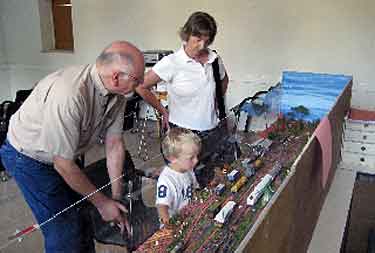
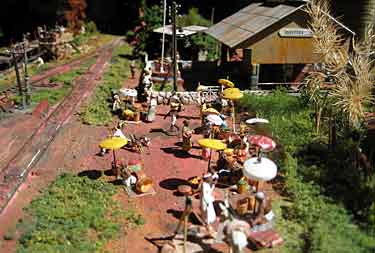
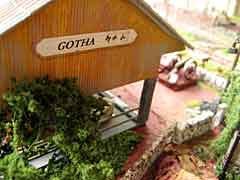
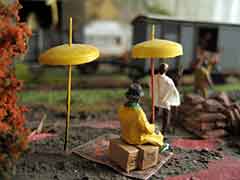
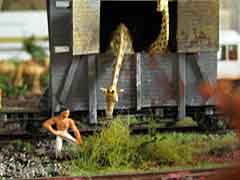
Gotha is a town roughly in the center of Ethiopia, on the Gotha Shet (“Gotha River” in Ethiopian). In this HOm model (1:87 scale on 12mm track) Gotha is a station on the CFFE (Chemin de Fer Franco-Ethiopien), the rail line between the capital of Addis Ababa and Djibouti on the Red Sea. The time is 1923, in the days of the Empress Zawditu. The model was built by Rainer Spohr(top left), from Kassel, Germany, and is an exotic railway to say the least!
Gotha Upon Gotha Shet is built on three modules, each 100x50cm (39x20in). With a fiddle yard attached at each end, the passing scene features trains stopping to take on water and wood (the steam engines all burn wood), freight trains are overtaken by passenger trains, and other trains conduct meets at the station.
But the most exciting part of this layout is the authentic scenery and railway equipment, including the colorful marketplace beside the station, the guards protecting the building, the iron bridge over the River Gotha, the ferryboat and cattle both crossing the water, and the special animal cars originally built for the Hamburg Zoo including pop-up cars for the giraffes and special cars for the apes. “There even was an accident,” relates Rainer. “One waiter for the apes was careless, and thus the apes took their food—bananas—with them and went all over the place… lively, even to the rooftops of the freight repair shed!”
Rainer remarks with pleasure that several German friends, who lived and taught school in Addis Ababa for more than 10 years, recently viewed the layout and remarked, “That´s exactly how it looks down there in Ethiopia… !”
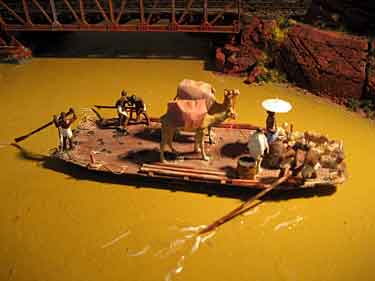
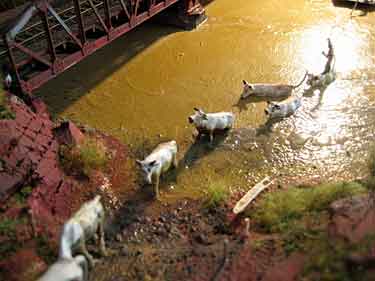

The hand drawn plan at the right shows the suppposed track arrangement at Gotha in 1923. The aerial photo beneath it showing the left-hand module will help you understand the arrangement. Gotha won third prize in a national model railway competition held two years ago by Eisenbahn Kurier magazine.
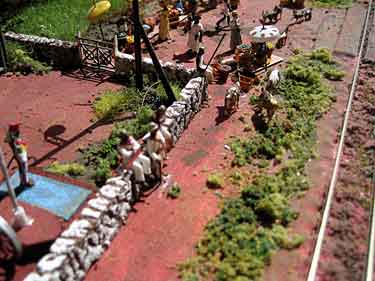
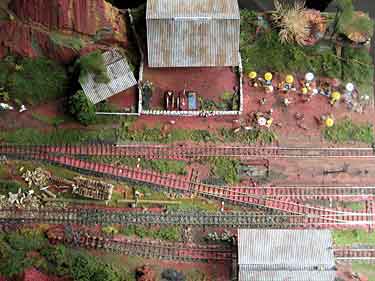
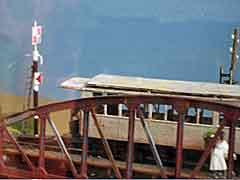
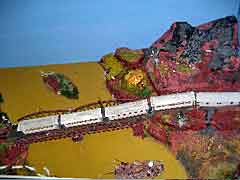
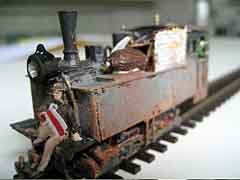
SIMPLE LINEAR LAYOUT SHOWS OFF ROLLING STOCK
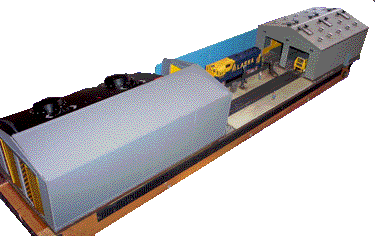
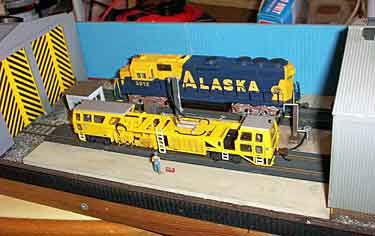
Dave Carson, from Stowmarket, Suffolk, England, spent some of his recuperation after surgery in building this 36x7in (90x18cm) “working diorama,” Fuel Pad. Two double-tracked sheds share a fueling point between them. Only one is used for stabling, however; the other shed hides the controller. Operation, though limited, affords an excellent opportunity to show off prized rolling stock in realistic surroundings.
SQUEEZING THE PROTOTYPE: THE LOS ANGELES ‘RAT HOLE’ DISTRICT
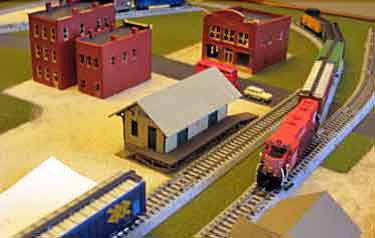
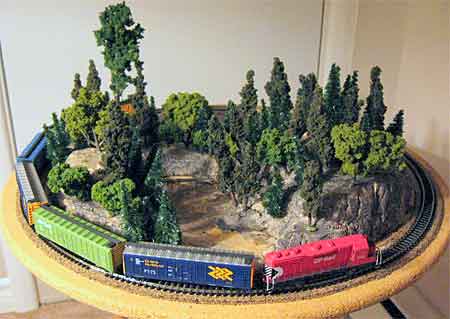
Frequent contributor MJ Idzerda, from London, Ontario, Canada, is coming to grips with the problem of deciding on a layout plan and actually starting construction. He’s decided on a 6x1ft (180x30cm) HO shelf railroad (the kind he had as a boy), and wants if possible to build a direct copy of South Central Street near Alameda in Los Angeles—the Davies Warehouse Co. in the downtown Espee Rat Hole switching district, featured by Bob Smaus in Model Railroader magazine. Above and at right are MJ’s full-sized mockups of a reasonable facsimile of this scene that will fit on a shelf. The tracks have a seductive “S” curve and form a natural-looking Inglenook switching pattern. Looks good!
But wait! As happens to so many of us, another thought struck MJ as he was preparing to put saw to wood… and the result was another classic switching pattern… a Tymesaver (below). What did he do? Read on!

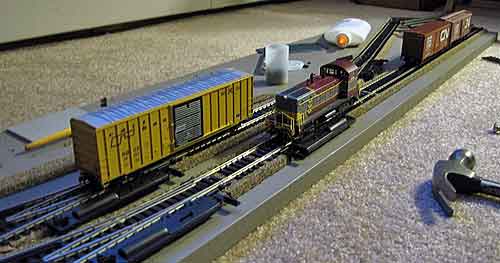
In MJ’s words: “The design files were reviewed, and plan v4.3 (based on a design from October 1993) was updated to fit. Voilà! Version 4.4 fits perfectly (above), has all the elements I want, and is essentially a timesaver! The cork is coming this week (today if time allows)!”
The cork arrived, MJ laid the track, and the results are shown at left. Next steps: operations and scenery! We’ll keep you posted.
NARROW GAUGE IN THE ROMANTIC ENGLISH LAKE DISTRICT
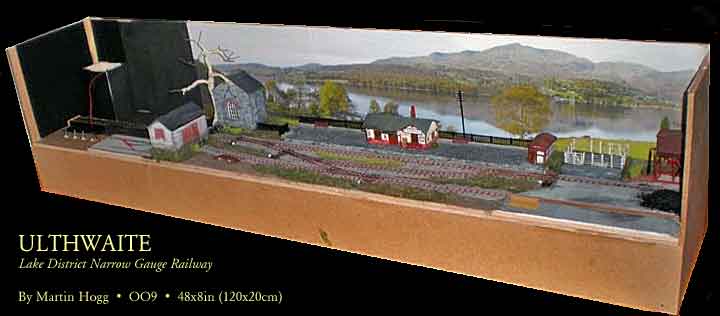
Martin Hogg, from Mansfield, England, seems to emit layouts at frequent intervals! One of his latest creations is Ulthwaite, a small town in the northern part of the English Lake District, the land of Wordsworth and Coleridge. Martin has imagined a narrow gauge railway terminus serving the more mundane needs of the community, such as “coal, goods and sheep being transported, as well as a few passengers and some tourists/walkers. It also is a place for small engines pulling ore skips from up the valley to run around before continuing off down towards the interchange.”
The board measures 48x8in (120x20cm) and is recycled from a previous layout. The rail line is OO9 (1:76 scale on 9mm gauge). Take a good look at the way Martin uses the photographic backscene… we seem to look down at the lake from a slightly elevated position (very common viewing angle in the Lake District), and the realism is almost uncanny (photo at bottom right shows this effect even more strongly). For more photos and information, see Martin’s blog.
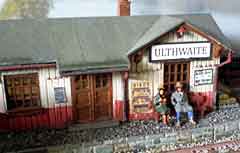
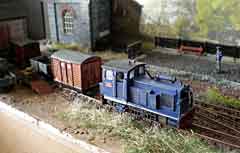
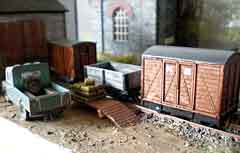
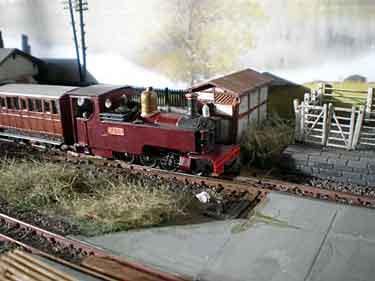
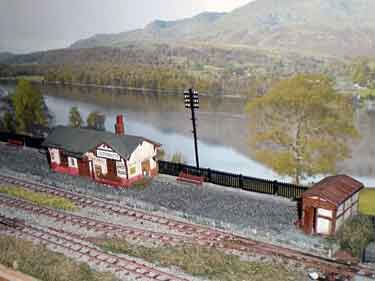
ANOTHER TRACKMOBILE LAYOUT… INGENIOUS USE OF A CD TURNTABLE!


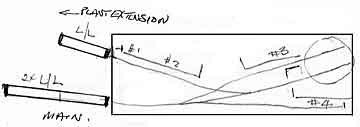
During those long Scottish winter nights, Shortliner Jack Trollope, way up in the Highlands, has been thinking about still more ingenious ways to make use of the tiny HO Trackmobile model that was featured in our layout design competition earlier this year. Jack’s latest cogitation is shown here… an unspecified industrial site using a Trackmobile to move cars (wagons and vans) around. Jack has used to good advantage Chad Wilkinson’sclever hidden-turntable idea to reverse the TM and make it appear to wheel around off the track (Chad introduced the idea in his contest entry.) Jack’s layout description follows:
“The disc at the right is a CD (hidden inside/behind the building), used as a turntable to turn the Trackmobile, allowing it to link to both ends of cars without modification. One side is hidden inside the building (Pikestuff or similar) and the other appears to run behind it. Use of a double length Peco Loco Lift at left end as fiddle yard (see sketch) extends tracks and allows stock changes. The track top left could use the same system (or possibly just a standard single one) to allow stock to go ‘deeper’ into the plant.” Double-length Loco Lift is described inScrapbook #80.
PRIZE-WINNING LAYOUT MODELS BELGIAN TRAM TERMINAL IN 1960’S

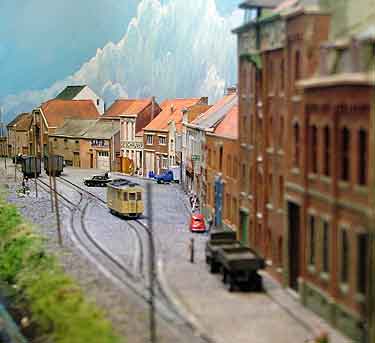
Roderik Vanderkelen, from Tollembeek, Belgium, built this tramline (trolley line) a few months ago as an entry in a mini-layout competition of Modelspoor magazine. He reports:
“Here are a few pictures of Ninove, the Nm scale (1:160 on 6.5mm gauge) entry which got me a third place. It depicts the endstation of the Belgian SNCV-tramlines Brussels-Ninove and Leerbeek-Ninove in 50s and 60s of the last century. All the buildings are copies of the originals. They are constructed in cardboard. The trams and wagons are also handmade from a lot of Märklin and Micro-trains Z scale pieces. I also include an old picture which shows the situation in the 1960s.
“More info (at the moment only in Dutch) can be found on this site.”
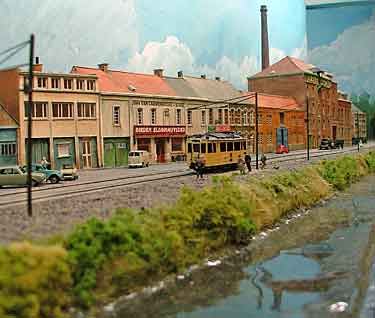
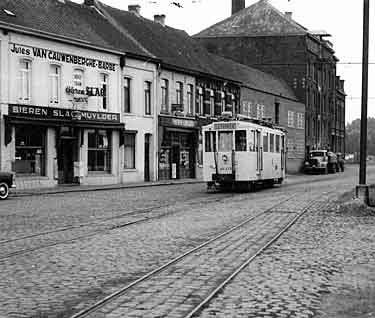
Leave a Reply